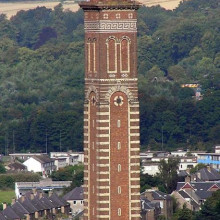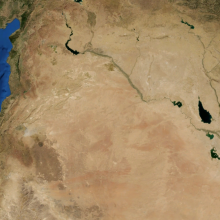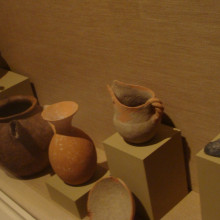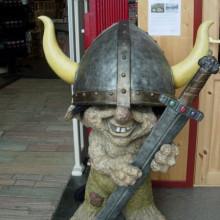Detailed Science of Dating, Data and Ceramics
This month: the most recent Neanderthals in the Caucasus, the science of ceramic petrology, the truth about 'The Anthropocene' and Syrian hunting traps. Plus, in Backyard Archaeology we explore the uses of the National Monument and Historical Environment Records.
In this episode

09:53 - The Anthropocene
The Anthropocene
DUNCAN:Earlier this month, a major conference was held at the Geological Society in London to discuss something that will not only have implications for scientists in the future when they refer back to the current geological epoch, but also for own understanding of our place in Earth's history.
DIANA:So this is the conference on the "Human Age"?
DUNCAN: Exactly right. The term 'Anthropocene' or "Human Age" was coined in the year 2000 by Nobel Laureat atmospheric chemist, Professor Paul Crutzen, who made up the term whilst at a conference on the Holocene - the officially-termed current geological epoch.
TOM: What makes a geological epoch, Duncan?
DUNCAN: Well, the history of the Earth is measured by a time scale that is systematically divided into units (and sub-units) according to major geological and/or palaeontological events, such as climate change and mass extinctions - the stand-out example there being the 'Cretaceous - Tertiary Extinction Event' that wiped out numerous plant and animal species, including the dinosaurs, around 65.5 million years ago.
TOM: So, according to the geological time scale where are we currently situated?
DUNCAN: We are currently 12,000 years into the Holocene epoch (11,700 years to be more precise!), which is a sub-unit of the Quaternary period that started about 2.6 million years ago, which is in turn is a sub-unit of the Cenozoic era that started after the K-T extinction event 65.5 million years ago. Interestingly, for all those etymologists out there (!) 'Cenozoic' comes from the Greek «καινός ζωή», which means "new life".
DIANA: But that's all about to change, right? How will it impact us archaeologists?!
DUNCAN: Archaeology is principally concerned with the study of material culture, so you could argue that our field of interest spans from the development of the earliest stone tools in East Africa around 3.4 million years ago, right up until the development and use of materials in modern times. In geological terms, we are focussed on the study of humans from the end of the Pliocene epoch, a period of relatively cold and dry environmental conditions, through the Pleistocene, a period that was marked by repeated glacial cycles (or Ice Ages), to the warm and relatively stable climatic conditions of the Holocene. However, scientists are debating whether or not the huge impact humans have had on the planet in recent times warrants the transition into a new geological time period: the 'Anthropocene'.
TOM: So, how will archaeologists and Earth Scientists in the future recognise our period in the geological record?
DUNCAN: That's a great question, Tom, and one that feeds quite nicely into the debate: if we have actually switched into a new geological epoch, then when does the 'Anthropcocene' actually start and how do we recognise it? Dr. Jan Zalasiewicz from the University of Leicester summarised three potential boundaries or 'event horizons' for the 'Anthropocene' as follows: firstly, the rise of agriculture around 10,000 years ago, secondly, the Industrial Revolution around 200 years ago with increasing carbon dioxide in the atmosphere, or thirdly, the end of the Second World War - the first atom bomb tests and dawn of the nuclear age.
DIANA: Yes, I suppose all three have had fundamental impacts on the environment and Earth's atmosphere, leaving indelible traces in the geological and archaeological record. Bomb testing alone has altered the levels of carbon-14 in people's bodies compared to 100 years ago.
DUNCAN: Absolutely, but Dr. Zalasiewicz is a keen proponent of the third option. He maintains that the "tell-tale radioactive signature from the first atom bomb tests in the [United] States" in 1945 would allow Earth Scientists in the future to identity the start of that particular stratigraphic layer. Also, Professor Will Steffen from the Australian National University supports the idea of the 'Anthropocene' starting in 1945 for another reason: it marks the beginning of the "Great Acceleration".
DIANA: What's the "Great Acceleration"?
DUNCAN: Professor Steffen has plotted a graph that tracks the growth of human population from the year 1800, the Industrial Revolution, to the present day, and his results are nothing short of extraordinary. From the period 1945 to the now the global population has doubled to a startling 6.9 billion people. Population growth is a serious issue and one that is putting unprecedented pressure on natural resources. As a result, the acceleration in biodiversity loss and species extinction is running 100 to 1000 times faster than normal background levels, and the rates are speeding up. There is no doubt about it. We are having a devastating effect on our planet and if geologists exist in the future, and look back at our own time period, they will say that the 'Anthropocene' represented one of the biggest extinction events in history.
TOM: Coupled with that I suppose there are warming temperatures and a gradual rise in sea-level.
DUNCAN: You're absolutely right, Tom. Dr. Mike Ellis of the British Geological Survey said that rising sea-levels would result in the amazing preservation of entire "cities buried in mud". So, as frightening as it sounds, with all the urban debris, plastic nuclear radiation, and goodness knows what else, we will be uniquely recognisable in the sedimentary deposits for future generations of archaeologists to study. I'm not entirely sure that's a good thing, but there you go (!)

15:15 - Syrian kite hunting traps
Syrian kite hunting traps
TOM: Imagine a group of British Army Air Corps pilots flying over the deserts of the Near East in the early years of the 20th Century. From the cockpits of their bi-planes they could see strange lines and circles seemingly etched into the landscape below. These airmen dubbed the bizarre shapes 'desert kites' and were spotted throughout the region of what is now northeast Syria.
DIANA: They're not an ancient Syrian equivalent of the Nazca Lines in southern Peru?
TOM: Not as mysterious, I'm afraid! Although fairly gruesome, I have to say! Archaeologists have discovered the remains of more than a hundred Persian gazelles - Gazella subgutturosa - in what has been described as a 'killing zone': a structure that consists of a converging pair of low stone walls, which were used to channel migrating gazelles and other animals into enclosures, and pits where the animals were slaughtered and seemingly processed en masse.
DUNCAN: This is a lot like the hunting traps from Lake Huron that we reported on two years ago. So to catch prey, you funnel them into a small area and then rain down a few arrows, spears or even clubs. Have they been able to date the killing zones, Tom?
TOM: Dr. Guy Bar-Oz from the Zinman Institute of Archaeology at the University of Haifa in Israel has suggested that these structures could date to around 10,000 years ago, so during the early stages of agriculture in the Near East. But the large number of skeletal remains of gazelles at this particular site of Tell Kuran, near the town of Hasseke in the Khabur Basin has been dated to around 6,000 years ago. Careful analysis of the bones has found the tell-tale signs of butchery, including the removal of skin, so these animals were processed on site.
DIANA: Is this a one-off site or are there lots of killing zones with large deposits of animal remains in the region?
TOM: Well, archaeologists have long-suspected that these strange walled enclosures had something to do with hunting gazelles and/or other herds of migrating animals, but there hasn't been much definitive evidence for mass slaughter at these sites. There are lots of 'desert kites' throughout the Near East, especially in modern-day Jordan, but, according to Dr. Bar-Oz, this particular site seems to represent a "catastrophic hunting episode - [where] a full herd was killed."
DUNCAN: How do they know it was a full herd?
TOM: The demographic of the herd suggests an equal number of males and females, as well as a few juveniles of two or three months of age. That's unusual, because ancient hunter-gatherer societies tended to conserve herds and only take what they needed. The removal of an entire herd would have had a big impact on local gazelle populations in the Khabur Basin. The question of 'over-hunting' is a puzzling one.
DIANA: So, what's their explanation?
TOM: It's likely that the community at Tell Kurun were agricultural and kept their own herds of livestock. They may have been reducing the number of gazelles in the local area to create more space for themselves. However, the archaeologists also think that something profoundly spiritual might be going on: nearby rock art from this period depict scenes of mass slaughter. Perhaps the ritualistic killing of entire herds performed an important social or spiritual function in the lives of these early agriculturalists? Either way, the impact it would have had on local gazelle populations in that region would have been devastating.

19:19 - Ceramic Petrology
Ceramic Petrology
with Xenia Charalambidou, University of Athens
Xenia explains the uses of ceramic petrology - the study of ceramics using microscopy, chemicals and thin sections. What extra information can such an in-depth study of pottery provide?

26:08 - Backyard Archaeology - Scouting for Information
Backyard Archaeology - Scouting for Information
with Ben Raffield, University of Aberdeen
Making use of the Historical Environment Record, the National Monument Record and the Urban Archaeological Database to look at the Viking 'Dark Age'.









Comments
Add a comment